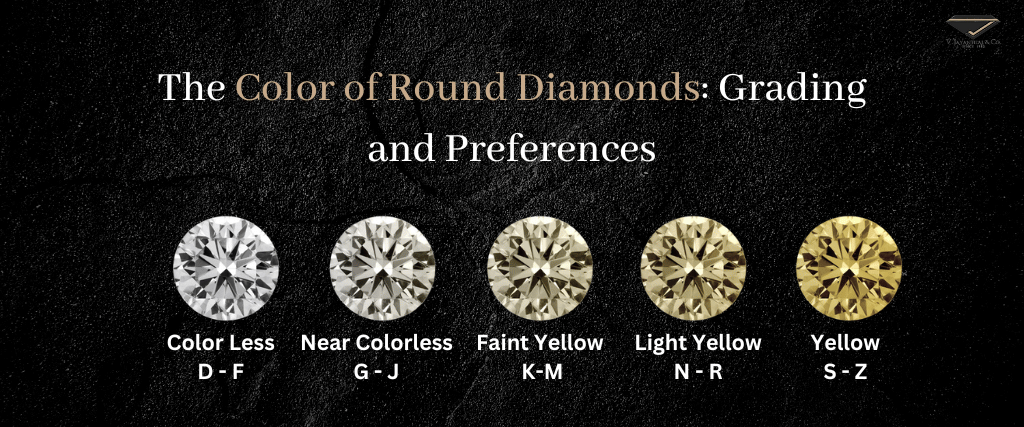
The color of round diamonds is a crucial factor influencing their appearance and value. In the world of diamonds, color is graded on a scale from D to Z, with D being completely colorless and Z having noticeable yellow or brown tint. Let's delve into the intricate details of diamond color, exploring its significance, grading system, and how it impacts a round diamond's overall beauty and value. Diamond color is determined by trace elements or structural defects within the crystal. The absence of color, particularly in the case of D-grade diamonds, allows for maximum light reflection and refraction, enhancing their brilliance and sparkle.
Introduction to Diamond Color:
Diamonds, formed deep within the Earth's mantle under intense pressure and heat, often contain trace elements that impart color. The Gemological Institute of America (GIA), one of the foremost authorities in gemology, established the diamond color grading scale to evaluate the presence of color in diamonds. The scale ranges from D (colorless) to Z (light yellow or brown), with D being the most valuable and highly sought after. The presence of color in a diamond can greatly affect its value and appeal to buyers.
The GIA Color Grading Scale:
‣ D-F: Colorless
Diamonds in this range are considered colorless, exhibiting no discernible color to the naked eye. These diamonds are extremely valuable and rare.
‣ G-J: Near Colorless
Diamonds in this range may display a hint of color, but it is usually challenging to detect without close inspection. They offer an excellent balance between quality and value.
‣ K-M: Faint Color
When viewed face-up, diamonds in this range may exhibit a faint yellow or brown tint. This color becomes more noticeable as you move down the scale.
‣ N-R: Very Light Color
Diamonds in this range have a more noticeable color, even to the untrained eye. They are often more affordable but may not provide the same brilliance as higher-grade diamonds.
‣ S-Z: Light Color
Diamonds in this range have a noticeable color that can affect their appearance. They are generally considered less desirable for engagement rings and other jewellery.
The Impact of Diamond Color on Appearance:
The presence or absence of color significantly influences a diamond's appearance. Colorless diamonds allow more light to pass through, creating a dazzling play of light and enhancing the diamond's brilliance. As you move down the color scale, the tint becomes more apparent, affecting the diamond's sparkle. This is because colored diamonds absorb some of the light that enters, resulting in less light being reflected the viewer. This can make the diamond appear duller and less vibrant than a colorless diamond.
Why Are Some Diamonds Colored?
When diamonds are formed deep in the Earth’s crust from extreme heat and pressure that cause carbon atoms to crystalize, sometimes foreign particles are trapped during the crystallization process causing a diamond to have a slight or noticeable hue.
Yellow diamonds acquire their tint from traces of nitrogen in the diamond, which causes blue light to be absorbed and yellow to orange hues to be reflected. Pink diamonds are created due to a distorted crystal lattice that causes the diamond to absorb a specific band of green rays. Blue-tinted diamonds absorb boron, which bonds with carbon to absorb green, red, and yellow light rays.
Determining Diamond Color:
Gemologists typically assess Diamond colour under controlled lighting conditions. The stones are compared to a set of master stones, each representing a specific color grade. The color grading is based on the absence or presence of subtle tones that may not be easily distinguishable to the average person. Gemologists use a standardized color grading system to accurately assess the color of diamonds. This system allows them to identify even the slightest hue, saturation, and tone variations. By comparing the stones to a set of master stones, gemologists can determine the precise color grade of each diamond, ensuring consistency and accuracy in their assessments.
Factors Influencing Diamond Color Perception:
‣ Setting and Metal Color:
The choice of metal for the setting can impact how the color of round diamonds is perceived. For example, a diamond with a slight tint may appear whiter when set in white gold or platinum.
‣ Diamond Cut:
The cut of a diamond, particularly its ability to reflect light, can influence how color of round diamonds is perceived. A round diamond cut type may mask some color, enhancing its overall appearance.
‣ Rarity and Value:
Colorless diamonds (D-F) are the rarest and, therefore, the most valuable. As you move down the color scale, the abundance of diamonds increases, making them more accessible but potentially affecting their value. However, personal preferences, budget considerations, and the aesthetic you desire in a diamond also play a crucial role in determining value. The diamond's cut, clarity, and carat weight also contribute to its value. A well-cut diamond with high clarity and a larger carat weight will generally be more valuable, regardless of its color grade. The market demand for certain colors may also impact a diamond's value. For example, fancy-colored diamonds like pink or blue are highly sought after and can command higher prices than colorless diamonds. Ultimately, the value of a diamond is subjective and can vary depending on individual preferences and market trends.
Popular Choices and Trends:
While colorless diamonds are timeless and classic, some individuals prefer the warmth and character that slightly tinted diamonds can offer. Fancy colored diamonds, which fall outside the traditional color scale, have also gained popularity for those seeking unique and distinctive options. These colored diamonds come in various hues, from soft pastels to vibrant shades, allowing individuals to express their individuality and personal style. Additionally, fancy colored diamonds are often considered rare and valuable, making them a coveted choice for collectors and investors alike.
Diamond Color and Certification:
When purchasing a round diamond, obtaining a diamond grading report from a reputable gemological laboratory such as the GIA, AGS, or EGL is essential. This report provides detailed information about the color of round diamonds, among other characteristics, giving buyers confidence in the quality and authenticity of their purchase. The color grading of a round diamond is particularly important as it directly affects its value and overall appearance. The diamond grading report will specify the color grade on a scale from D (colorless) to Z (light yellow or brown), allowing buyers to decide based on their preferences and budget.
Conclusion:
In the intricate world of diamonds, the color of round diamonds is a key factor influencing their beauty and value. Understanding the GIA color grading scale, the impact of color on appearance, and the various factors influencing color perception allows consumers to make informed decisions when selecting a diamond. Whether you prioritize a colorless gem for its timeless elegance or appreciate the warmth of a slightly tinted diamond, the choice ultimately depends on your preferences, budget, and the significance of the diamond in your life.
Diamond Company in Surat at V. Jayantilal & Co., we inspect every single diamond in our inventory for cut, clarity, carat, and color of round diamonds to ensure the highest quality diamonds for our clients. Whether you prefer a colorless diamond or you prefer a near-colorless solitaire diamond, your diamond color choice is completely and personal.







